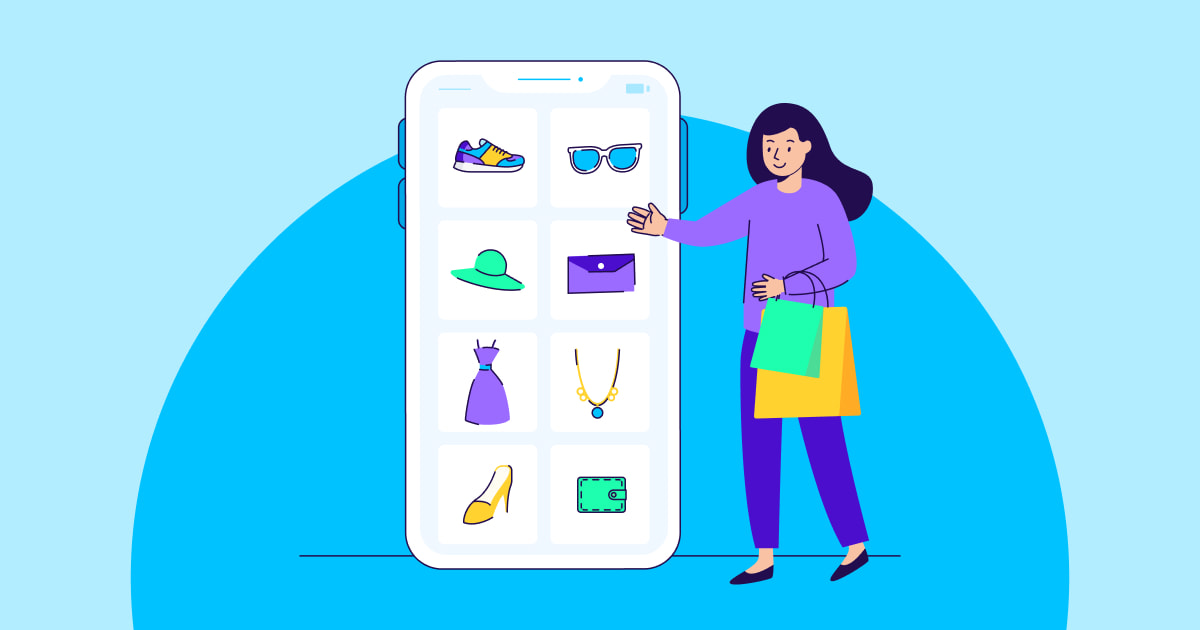
Introduction
Where would you be without your mobile phone? If the answer is “completely lost”, you’re not alone.
In recent years, that little device in our pockets has progressed from handy communication tool to life essential. Increased access to high-speed WiFi has played a part, and the trend was accelerated by the Covid pandemic. From your grocery shop to your doctor visit to your bank transactions, suddenly everything had to be done online.
And one area where we just can’t put our phones down is mCommerce. The convenience of buying, selling, and making payments from the palm of our hands has proved irresistible. So much so that mCommerce transactions reached a staggering 2.2 trillion US dollars globally in 2023 — that’s up from around $359 billion in 2021, and it’s set to surpass $3 billion by 2027.
As a marketer, this is an opportunity you don’t want to miss out on — and we’re here to help you make the most of it. In this guide, we’ll dig into what mCommerce means, the benefits of this technology, and how to make it work for your business.

What’s m-commerce?
mCommerce (or m-commerce) is short for mobile commerce, which is the buying and selling of products and services via a mobile device. While eCommerce refers to any financial transaction conducted on the internet, mCommerce is specific to mobile devices — think mobile shopping, banking, and payments.
Chances are, you’ve used at least one mCommerce service as a customer today. And, with mCommerce now making up 60% of eCommerce transactions (and rising), it’s something all businesses need to invest in.
What are the mCommerce service types?
When you think of mCommerce, the first thing that springs to mind might be shopping apps. But there are various other types of services too – let’s take a look.
Mobile shopping
The two most popular mobile shopping services are dedicated shopping apps and mobile-first websites. But mobile shopping also includes social shopping platforms, like Pinterest, Facebook, and Instagram, that allow users to make purchases from online stores.
Mobile payments
Mobile payment apps, also known as digital wallets, are apps that are linked to bank accounts to quickly and securely make purchases using a mobile device. Examples include Apple Pay, Google Pay, and Visa Checkout.
Mobile point of sale (POS)
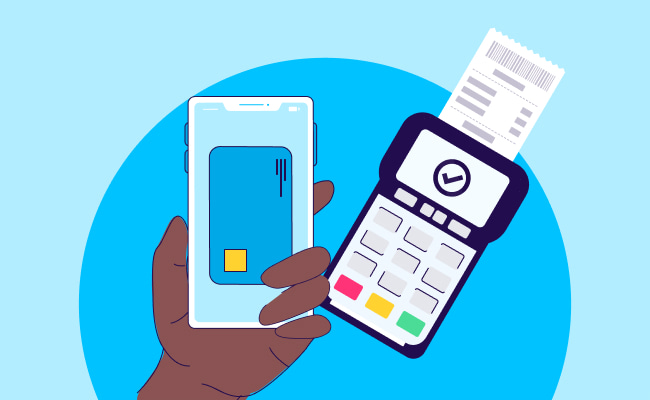
Mobile point of sale systems enable stores to accept payments and process transactions from customers who pay using their mobile devices. This often includes contactless payments for Apple Pay and Google Pay, while the associated systems consist of not only the hardware, but also the software and payment processor.
Person-to-person mobile payments
Person-to-person or peer-to-peer (p2p) payment apps enable people to exchange money. Whether you’re splitting a dinner bill, making a donation, or paying rent, p2p mobile payment apps are connected to individual bank accounts to help users easily transfer funds. The most popular apps include Venmo, PayPal, and CashApp.
Fintech: mobile banking and investments
Mobile banking and investment apps allow users to access bank accounts, make payments, manage investments, pay off loans, and access other financial services, making financing apps like Klarna and Afterpay exceedingly popular in the mCommerce world.
mCommerce vs eCommerce: What’s the difference?
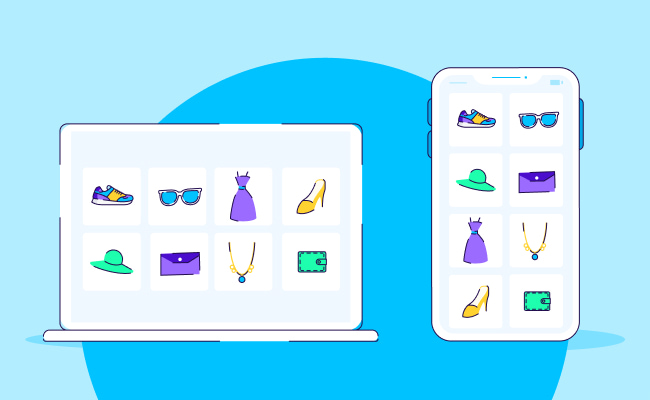
eCommerce is the umbrella term that refers to the buying and selling of goods and services online. mCommerce is a subcategory of eCommerce, specific to online transactions using mobile phones and tablets.
Below, we explore the key differences between them and how consumers use these different solutions.
Mobile-first economy
We’re carrying out more and more day-to-day activities on our phones, and there are two key drivers for the shift: convenience and security.
For example, with digital wallets like Apple Pay, making a purchase on your phone is a frictionless experience. You only need to upload your credit card information once, and you can make purchases with a tap of a button.
Crucially, it’s safe and secure: digital wallets require additional authentication methods to protect your data, such as Face ID or Touch ID, whereas desktops don’t.
In response to this trend, companies are adopting a mobile-first approach — and that doesn’t just mean optimizing your website for mobile. Research shows that mobile users spend around 90% of their time in apps, rather than mobile websites. Customers prefer apps because they’re faster, can be used offline, and provide a more engaging, personalized experience, which in turn leads to higher conversions.
mCommerce technology is leading innovation
As mobile takes over, this is where companies are investing. As a result, mCommerce technology is improving faster than ever before. Mobile wallets are becoming more secure, p2p payments are more prevalent, and brands are finding better ways to integrate mobile technology into their marketing mix.
Ikea, for example, has an augmented reality app to help shoppers measure and visualize how a furniture piece would fit their homes.
mCommerce and eCommerce purchase behaviors are worlds apart
As customers increasingly turn to apps over mobile websites, it’s vital to invest in the experience to help your app stand out and keep users engaged.
When it comes to small purchases, users want to shop on the go, at the tap of a button. For higher-cost items, comparing prices and reviews is a key part of the purchase journey. mCommerce also has close ties with social media: purchases are often driven by friends or influencers, and the shopping experience needs to be seamless.

The advantages and disadvantages of m-commerce
Embracing mobile commerce offers businesses unparalleled opportunities for growth and customer connection.
Benefit #1: Reach your target customers faster
Investing in mCommerce enables businesses to take on a true omnichannel marketing approach, allowing them to reach their target customers at the right time and place.
Whether it’s through push notifications, offering in-app rewards, or geotracking, you can engage with your customers faster and more accurately than ever before.
Benefit #2: Consumers prefer apps
As mentioned earlier, consumers prefer apps over mobile websites. For starters, apps are typically 1.5 times quicker to load — and users expect a website to load in under three seconds.
And your mCommerce experience can make or break your business: 57% of customers won’t recommend businesses with poorly designed mobile sites.
Benefit #3: High adoption rates
With nearly seven billion smartphone users in the world today, this is a channel you don’t want to miss out on. Take the UK, for example, where almost 100% of 18-24 year olds currently own a smartphone: that’s a huge audience ready to engage with your app. Meanwhile, US consumers made 63% of online shopping orders on mobile in 2023.
As the popularity of mCommerce continues to rise, consumers are getting smarter and the demand for stellar user experiences will only increase.
Benefit #4: mCommerce customers are quicker to purchase
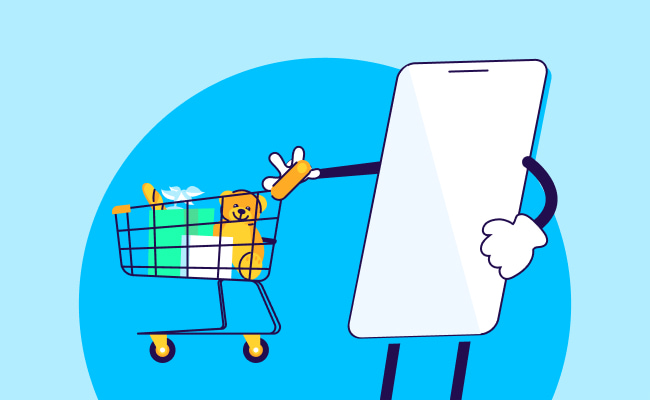
Customers have an accelerated buyer journey on mobile for several reasons:
- Apps outperform browsers in load times, making for a frictionless user experience.
- Apps are downloaded and stored and help users save buffering times with preloaded preferences.
- The payments ecosystem has improved tremendously and reduced friction from view to purchase.
- One-click purchasing and mobile wallets have made it safe and easy to purchase online.
- Social shopping platforms like Facebook, Instagram, and Pinterest have improved the mobile shopping experience.
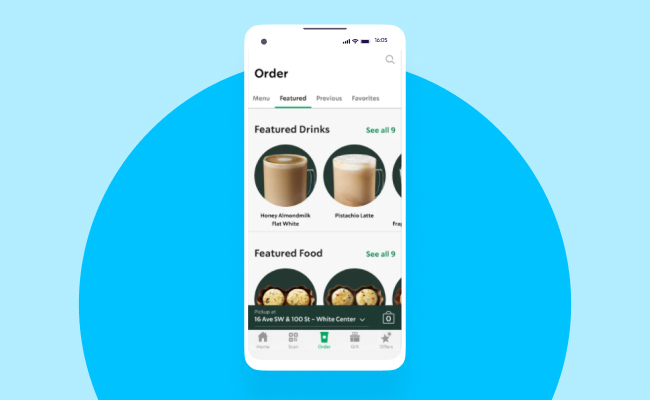
The challenges of mCommerce
While there are tremendous upsides to mCommerce, there are also a few drawbacks to consider.
Challenge #1: Increasing data privacy concerns
With growing user concern over how their data is being used, mCommerce providers need to clearly articulate how they’re keeping customer data safe and secure.
What’s more, privacy-first initiatives like Apple’s ATT policy have created challenges for marketers in measuring and attributing campaigns. Working with a trusted mobile measurement partner can help you access the data you need to make informed decisions, without compromising user privacy.
Challenge #2: High startup and maintenance costs
As mentioned previously, simply optimizing a desktop eCommerce site for mobile is not enough. To remain competitive in a highly saturated marketplace, brands must invest in the development and maintenance of apps and mobile-first websites, which could be resource-intensive.
Challenge #3: Stiff competition
As more and more companies see the potential of mCommerce, how do you make your offering stand out?
First, you need to be crystal clear on the benefits of your app and communicate these effectively to potential users. Then, it’s down to a relentless focus on user experience, to make your app as streamlined and intuitive as possible. That means constantly measuring and optimizing user engagement, and finding ways to keep customers coming back.
Challenge #4: Risk of fraud
Customers may, understandably, be wary of inputting their payment details for mCommerce purposes. Mobile phones often get lost or stolen, putting user data at risk. Moreover, where mobile shopping often involves small, frequent purchases, fraudulent activity is easier to miss. To earn customers’ trust, you need secure payment facilities and robust fraud detection capabilities.

mCommerce best practices
A scaled-down desktop shopping experience is not nearly as effective as a mobile-first approach. Due to the vast differences in purchase behavior between mobile and desktop shoppers, mCommerce experiences require their own strategic design and user experience.
So, here are the top strategies to make your mCommerce business a success:
1.Start with a great onboarding experience
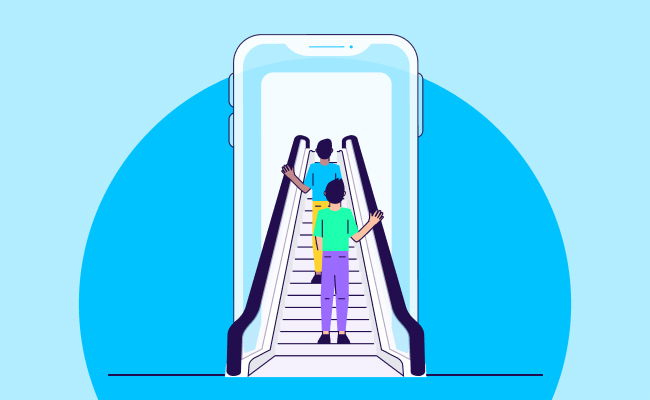
First impressions count: you need to showcase your app’s coolest features right from the off, while making it a breeze to start using your service. Only ask customers for the info you really need, and keep your prompts short and sweet – they should be able to navigate the app in just a few steps.
2. Load quickly
Knowing that over 61% of Google searches are now on mobile devices, Google has begun penalizing sites that don’t deliver great mobile shopping experiences. According to their research, a one-second delay in mobile load time can impact conversions by up to 20%, so ensure your website and apps load quickly.
3. Offer easy search and personalized suggestions
There’s no way to showcase all your products and services on one small mobile screen. Ensure there’s an intuitive filtering and search system that allows mobile users to narrow down their search and look for products that meet their specific needs.
Additionally, be sure to provide personalized product suggestions based on their shopping behavior.
For example:
- Amazon uses a ‘people also bought’ feature that shows what products pair well with the one in your cart.
- Consider providing auto-fill suggestions in the search history to speed up searches.
- Ensure your search results are reliable and accurate.
4. Streamline the checkout process
Every slow loading screen, poorly timed pop-up notification, or misplaced button can cause a mobile shopper to second guess their purchase and abandon their shopping cart.
You also need to thoroughly test your payment screen to prevent customers dropping out of your funnel. (Some abandoned carts are inevitable — check out step 7 to draw shoppers back in!)
5. Collect first-party data
In a privacy-first world, shaped by ATT and the upcoming cookieless internet, mCommerce services need to invest in collecting first-party data if they want to make informed business decisions.
For example, why not make email sign ups easy by providing a discount sent to your users’ inbox? You can also collect zero-party data, like quizzes that show personalized product recommendations on completion.
6. Set and test valuable KPIs
Always improve your shopping experience by measuring, testing, and improving the metrics that matter. Here are some KPIs to consider:
- Percentage of users converted into active users
- Cost per customer acquisition (CAC) per channel
- User retention
- Session length
- In-app purchases
- Average sale per user
- Average order value
- Purchase frequency
As well as these quantitative metrics, consider gathering qualitative data to further improve the user experience. A short survey — perhaps with an incentive for completion — can provide valuable insights into what people like and dislike about your app.
7. Re-engage with your audience at the right time
Whether the internet cuts out or a shopper hesitates at the very last minute, executing a re-engagement strategy can help push them over the finish line.
This could involve email, retargeted ads, push notifications, or text message — just make sure your messages are personalized, but used sparingly. You can also link directly to the abandoned cart, meaning checkout couldn’t be easier.
8. Make it accessible
North American and European laws are increasingly responsive to the needs of mobile users with disabilities. Ensure that your shopping experience is accessible to all by adhering to the following Web Content Accessibility Guidelines (WCAG): be perceivable, operable, understandable, and robust.
9. Make social media work for you
Social media is one of the most popular app categories, with the likes of TikTok, Instagram, and Facebook consistently featuring among the most downloaded and regularly used apps. These apps have a big influence on our shopping habits, too, so it’s vital to let customers shop from their favorite social platforms.
But don’t fall into the trap of trying to be everywhere all at once. Focus on the platforms where your customers spend most time, and work on building an engaged community there.
10. Enable quick payments
The faster your customers can check out, the more likely they are to complete the purchase. Allowing one-click payments and integrating with Apple and Google Pay will make the journey smoother and result in fewer abandoned carts.

The future of m-commerce
As mCommerce takes an ever-larger share of the eCommerce market, smart businesses know they need to invest in outstanding experiences. But what might that look like?
Let’s explore some of the key trends to watch.
Generative AI
Collins Dictionary crowned “AI” its word of the year in 2023 — and with good reason. The unstoppable rise of ChatGPT helped propel artificial intelligence from the realms of sci-fi to the mainstream. And, as the technology gets smarter, there’s enormous potential for mCommerce providers to develop and refine their user experience.
For example, generative AI can help with content creation, enabling you to rapidly update product listings and promote your offering to users. It can also facilitate more personalized experiences and smarter searches, predicting customers’ needs and interests to offer them exactly what they’re looking for — even before they know it themselves.
And don’t forget the benefits of AI for measurement and analytics. These tools can analyze vast quantities of data and pull out trends that would be hard for the human eye to spot. They can even trawl through reviews or social media comments to pick up on how customers feel about your brand, providing vital context for the numbers.
Omnichannel experiences
Despite the boom in mCommerce, it hasn’t replaced in-store shopping altogether. Increasingly, brands are finding ways to serve their customers across multiple channels.
One example is click-and-collect shopping, which was popularized by Covid safety measures. Think Starbucks or McDonalds, where you can order your food or drink and collect in store without waiting in line. It applies to bigger items too, such as ordering clothing or shoes and being able to try them on in store.
QR codes have proved a popular way to bridge the gap between online and offline experiences. Some stores let you scan a code on the shelf for product specs and reviews before you buy, seamlessly integrating the physical and digital worlds. Alternatively, QR codes on outdoor ads can take users straight from awareness to purchase.
Augmented reality as cost savings strategy

Shopping through your phone shouldn’t be limited to scrolling through an endless feed or products. As mobile technology improves, so will the mCommerce shopping experience. One way brands are doing this is by using augmented reality (AR) to make shopping more personalized and engaging.
Brands that use augmented reality to showcase products can more accurately set customer expectations by allowing them to try products before purchasing. This ultimately saves the business’ bottom line, as it reduces the number of product returns and complaints.
Rewarding loyalty
Coupons and discounts are a tried-and-tested way to re-engage customers with your mCommerce business. They take several forms:
- Loyalty programs
- Couponing apps
- Rebates, daily ads
- Promo codes
As well as being a low-cost way for mCommerce businesses to build loyalty, mobile couponing is super-convenient for price-sensitive customers, who can find the best deals through a single app.
In 2023, nearly 60% of US consumers used some form of digital coupon.
Voice search will become more natural
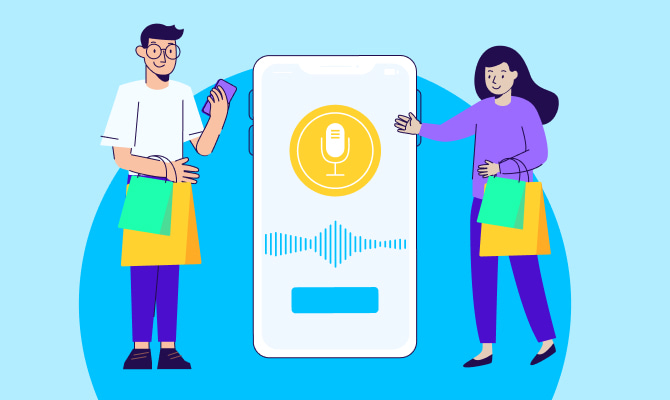
Hey Siri, did you know 62% of Americans use voice search? Well, now you do. Whether you’re washing the dishes or driving, we’re getting increasingly used to talking to our devices. More importantly for marketers, more than half of US consumers use voice search to find information about a product or service, making this a key part of the buyer journey.
The rise of bots
One of the big benefits of mCommerce is its convenience and availability. No need to rush to the store or bank before closing time — customers can access your services whenever, and wherever, they choose. That means, as a business, you need to be there for them.
Chatbots provide a cost-effective way to support your customers 24/7. Whether they’re answering queries, providing guidance, or suggesting products, these friendly, always-on bots can vastly improve the customer experience and ensure they get what they need. And they’re becoming more sophisticated all the time.

Key takeaways
- Mobile commerce, or mCommerce, is a subcategory of eCommerce that relates specifically to buying and selling on a mobile device. As well as mobile shopping, it encompasses digital wallets, mobile point-of-sale, peer-to-peer payments and fintech services.
- Paying on a mobile device is fast becoming the norm. Mobile transactions make up over half of all eCommerce business, and add up to around 2.2 billion US dollars globally.
- mCommerce and eCommerce behaviors differ, so it’s not enough just to have a mobile-friendly website. Customers increasingly prefer using apps to mobile sites, and businesses need to offer a true mobile-first experience to succeed in mCommerce.
- The convenience of mCommerce means it benefits from high adoption rates and quick purchase behavior. It also lets you reach your target customers faster. However, the challenges include privacy concerns and fraud risks, as well as the high costs of remaining competitive.
- Successful mCommerce businesses deliver an exceptional (read: frictionless) customer experience. That means fast loading times, easy onboarding, smooth payments, and plenty of personalization. Always consider accessibility, and develop a solid social media strategy. Finally, remember to keep gathering data, measuring your KPIs, and re-engaging with customers at the right time.
- AI will be central to the future of mCommerce, helping with everything from content generation to behavioral analysis. We’ll also see omnichannel approaches that integrate online and offline experiences, as well as augmented reality, loyalty coupons, and greater use of voice search and chatbots.

